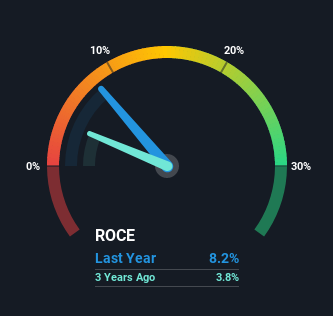- Malaysia
- /
- Energy Services
- /
- KLSE:CARIMIN
The Return Trends At Carimin Petroleum Berhad (KLSE:CARIMIN) Look Promising
To find a multi-bagger stock, what are the underlying trends we should look for in a business? One common approach is to try and find a company with returns on capital employed (ROCE) that are increasing, in conjunction with a growing amount of capital employed. Ultimately, this demonstrates that it's a business that is reinvesting profits at increasing rates of return. With that in mind, we've noticed some promising trends at Carimin Petroleum Berhad (KLSE:CARIMIN) so let's look a bit deeper.
Understanding Return On Capital Employed (ROCE)
Just to clarify if you're unsure, ROCE is a metric for evaluating how much pre-tax income (in percentage terms) a company earns on the capital invested in its business. To calculate this metric for Carimin Petroleum Berhad, this is the formula:
Return on Capital Employed = Earnings Before Interest and Tax (EBIT) ÷ (Total Assets - Current Liabilities)
0.082 = RM16m ÷ (RM305m - RM110m) (Based on the trailing twelve months to September 2021).
Therefore, Carimin Petroleum Berhad has an ROCE of 8.2%. On its own, that's a low figure but it's around the 9.6% average generated by the Energy Services industry.
Check out our latest analysis for Carimin Petroleum Berhad

Historical performance is a great place to start when researching a stock so above you can see the gauge for Carimin Petroleum Berhad's ROCE against it's prior returns. If you want to delve into the historical earnings, revenue and cash flow of Carimin Petroleum Berhad, check out these free graphs here.
What The Trend Of ROCE Can Tell Us
We're delighted to see that Carimin Petroleum Berhad is reaping rewards from its investments and has now broken into profitability. The company was generating losses five years ago, but has managed to turn it around and as we saw earlier is now earning 8.2%, which is always encouraging. On top of that, what's interesting is that the amount of capital being employed has remained steady, so the business hasn't needed to put any additional money to work to generate these higher returns. That being said, while an increase in efficiency is no doubt appealing, it'd be helpful to know if the company does have any investment plans going forward. So if you're looking for high growth, you'll want to see a business's capital employed also increasing.
On a side note, we noticed that the improvement in ROCE appears to be partly fueled by an increase in current liabilities. Effectively this means that suppliers or short-term creditors are now funding 36% of the business, which is more than it was five years ago. It's worth keeping an eye on this because as the percentage of current liabilities to total assets increases, some aspects of risk also increase.
In Conclusion...
To sum it up, Carimin Petroleum Berhad is collecting higher returns from the same amount of capital, and that's impressive. Since the stock has returned a staggering 115% to shareholders over the last five years, it looks like investors are recognizing these changes. Therefore, we think it would be worth your time to check if these trends are going to continue.
If you'd like to know about the risks facing Carimin Petroleum Berhad, we've discovered 3 warning signs that you should be aware of.
While Carimin Petroleum Berhad may not currently earn the highest returns, we've compiled a list of companies that currently earn more than 25% return on equity. Check out this free list here.
New: AI Stock Screener & Alerts
Our new AI Stock Screener scans the market every day to uncover opportunities.
• Dividend Powerhouses (3%+ Yield)
• Undervalued Small Caps with Insider Buying
• High growth Tech and AI Companies
Or build your own from over 50 metrics.
This article by Simply Wall St is general in nature. We provide commentary based on historical data and analyst forecasts only using an unbiased methodology and our articles are not intended to be financial advice. It does not constitute a recommendation to buy or sell any stock, and does not take account of your objectives, or your financial situation. We aim to bring you long-term focused analysis driven by fundamental data. Note that our analysis may not factor in the latest price-sensitive company announcements or qualitative material. Simply Wall St has no position in any stocks mentioned.
Have feedback on this article? Concerned about the content? Get in touch with us directly. Alternatively, email editorial-team (at) simplywallst.com.
About KLSE:CARIMIN
Carimin Petroleum Berhad
An investment holding company, provides technical and engineering support services for upstream oil and gas companies in Malaysia.
Excellent balance sheet with questionable track record.
Market Insights
Community Narratives



